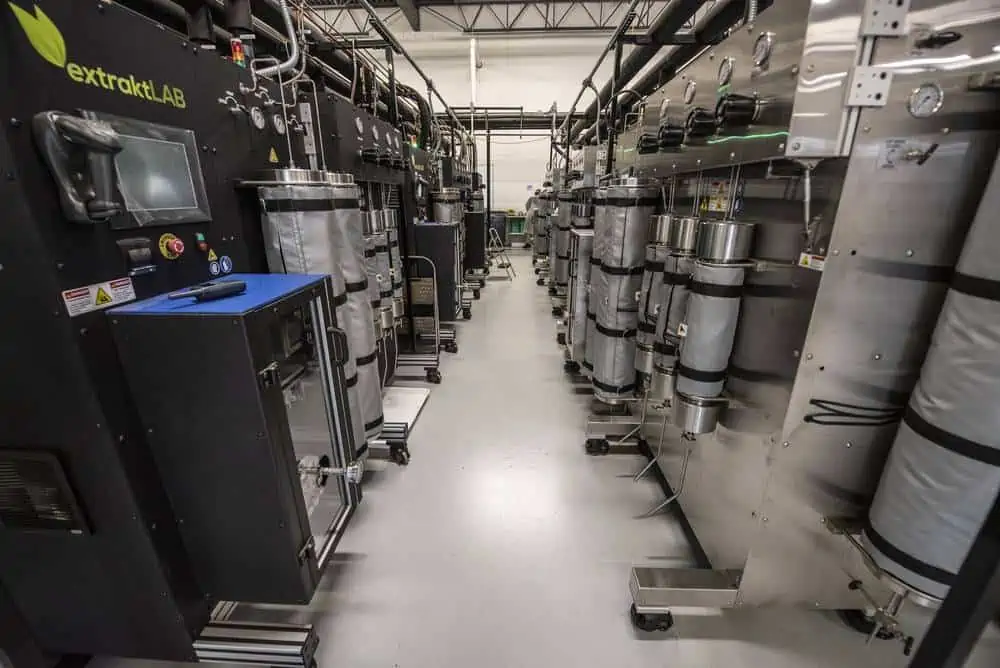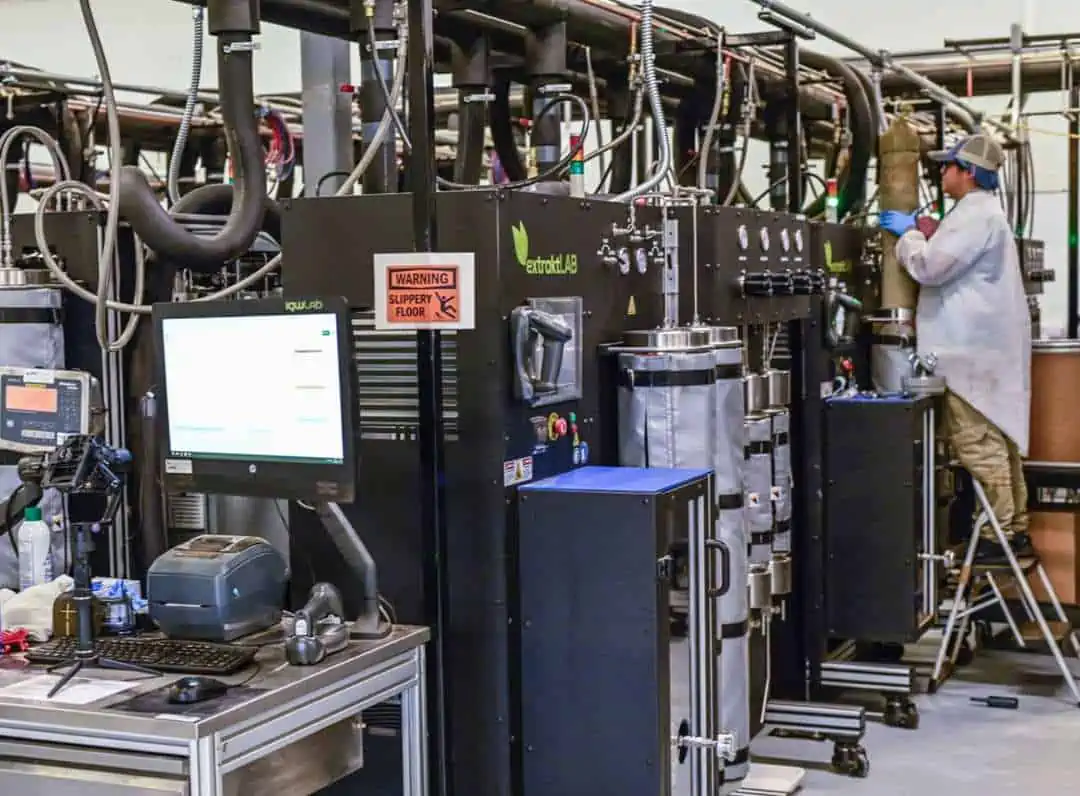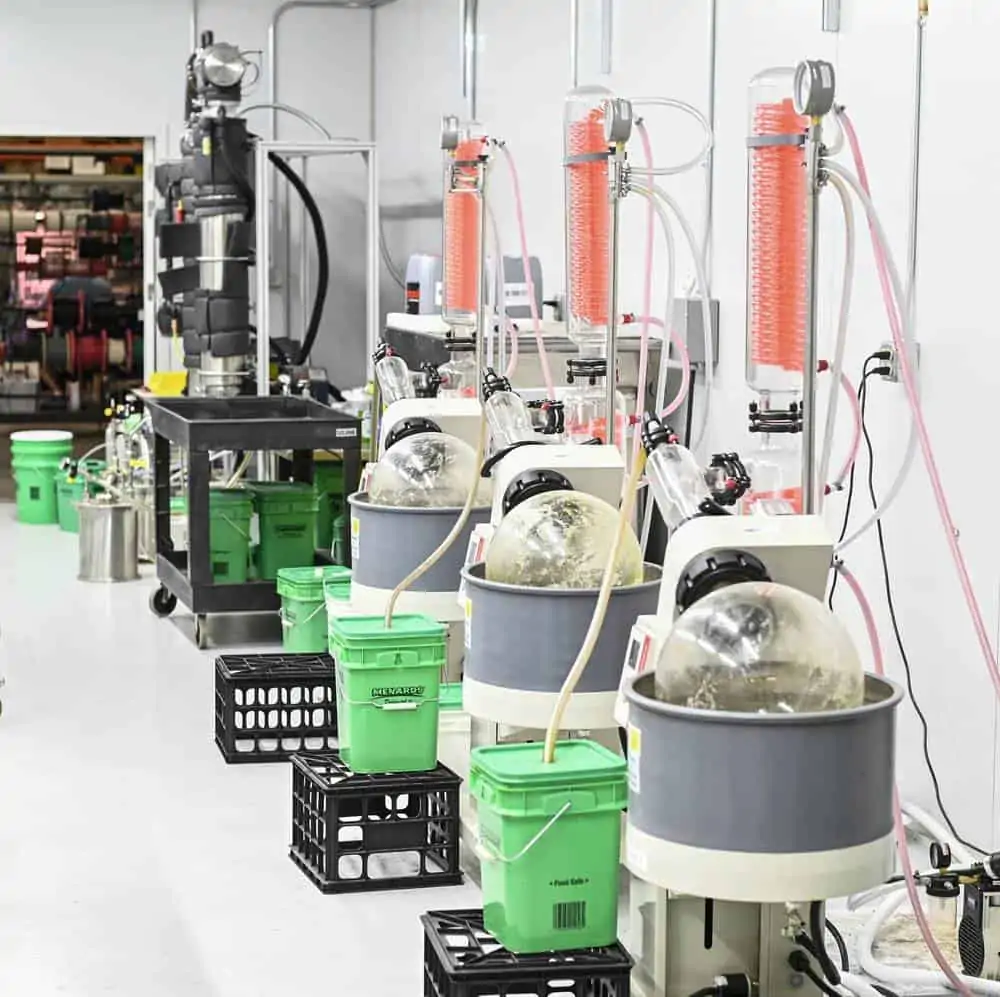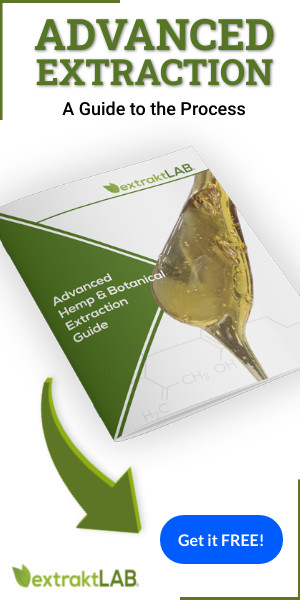C02 Extraction
In the world of hemp and other various plant extracts there are a variety of extraction methods by which these products are created. While some of these methods may benefit a certain producer, there are just a few common methods seen in the extraction industry that are being used to separate a specific compound from the fluid and only one of those few stands as the best option in terms of quality and profitability. Read on to learn more about various hemp and botanical extraction methods, necessary CO2 systems accessories, and which of these is the superior option for manufacturers and customers alike in the hemp and essential oil industries.
Guide to Extraction Method: The Best Techniques To Extract CBD
What is Extraction?
Extraction is a separation technique seeking to separate a target compound from its matrix. This is not the same as chromatography, filtration or distillation. The goal is to selectively remove the compounds desired from resin. This is done in a number of methods that are performed to create distillate and isolate extracts from botanical biomass.
Topics and Information Guide
- What is an Extraction Method?
- Analysis of Different Methods and Techniques
- Techniques and Systems to Make CBD Oil
- Different CBD Extraction Methods
- Subcritical and Supercritical CO2 Extraction Systems
- Organic CBD Oil Extraction at Home
- Essential Oil Extractor and Plant Oil Extractor Uses
- Final Analysis: What is the Best Extraction Method

What is an Extraction Method?
These methods are the different ways to separate target compounds from a fluid – such as separations of gases, liquids, liquid from solids, gas from liquid, and acids from base. Extraction methods always incorporate your method, accessories, and consumable.
CO2 Extraction Method Variables
Time: Lower the time for diffusion to take place.
Temperature: All solubility is a thermodynamic parameter, driven by surface tension.
Pressure: By adjusting the pressure in extraction method, the time until diffusion can be lessened, which affects other variables in a particular method.
Solvent Type and Composition from Extraction to Distillation
In order to separate the target compound from the resin matrix, the solvent must be able to dissolve and migrate into the resin molecule. Like compounds will dissolve like nonpolar solvents will dissolve only nonpolar resins.
Ideally, you want your botanical extraction to be as pure as possible. To achieve this and based on the method required, the target compound desired, the matrix it is in, and the solvent you wish to use – your extraction method will be developed. By experimenting with time, temperature, pressure, cycle, and gradient variables, measurements of selectivity will refine reproductivity and reliability – your method is now validated.

Analysis of Different Methods and Techniques
Mobility is an important criterion for various methods. Diffusion is the movement of material under a chemical potential rather than by mechanical convection. Lower viscosity allows for higher diffusion, providing better mobility and therefore the better the extraction will be. Mobility in solubility is what extraction is
Techniques and Systems to Make CBD Oil
If one thing has been established so far, it’s that proper extraction techniques are key to making CBD oil. Whether you are a newly developed large scale CBD manufacturer or an individual consumer learning how to make CBD oil or, there are oil extraction methods that can be used to create a safe and usable product.
There are a number of variables that play a part in which extraction method would be best for any particular producer. These may include the size of a facility, the accessories that area available, local jurisdictions, certification and training costs – so on and so forth.
However, among the most important factors that impact the quality of the end product as well as the long term costs and safety associated with them, solvents are the crucial factor in determining an effective extraction method. While there are a variety of solvent based methods by which CBD oil is made, there are three prominent to extract solvents that are used today.
Calculate Your Botanical Extraction Business Operating Cost
Starting a Botanical Extraction Business? Check out our Calculators and to analyze costs, estimated revenue, yield, initial investments and important metrics for your extraction business.
Different CBD Extraction Methods
What are the Different Techniques for Extraction of Oils?
Ethanol
Ethanol is a very effective method for extracting cannabinoids but is often used as denatured ethanol. Organic solvents like food grade ethanol is a safer option but it is often too expensive. Therefore, manufacturers commonly turn to denatured ethanol techniques which contains chemical denaturants used to deter recreational consumption and avoid alcohol taxes. Although denatured ethanol is created to prevent human consumption, it is still used in hemp extraction. In fact, the FDA allows for certain PPM of pentane, methanol, hexane and other denaturants in extracts that are still considered “safe” for consumption.
Hydrocarbon
Extraction using hydrocarbon solvent techniques is effective, but not totally safe in production or consumption. Common solvents in this category are hexane, propane and butane – all of which are flammable and cannot be considered organic solvents. This increases chances for fire hazards. For consumers it is not guaranteed that all of the solvent will be removed from a product even through a thorough distillation process. Though the remaining solvents would be minimal, little research has been conducted that daily use of these products is entirely safe.

CO2
Incredibly efficient in supercritical and subcritical states, CO2 is the safest, and most efficient extraction method with the lowest long-term costs for manufacturing. In its supercritical state, CO2 is converted to a liquid. It is important that the CO2 is a liquid in order to mix with the raw materials in order to strip the desired compounds during CO2 extraction. While ethanol and butane are not organic solvents, liquid CO2 is natural which also allows for obtaining organic certification and reduces harmful emissions that are harmful to the environment. There are no chemical denaturants or residuals left in a CO2 extraction process making it safe for regular human consumption without any question for concern.
Supercritical Extraction Machine
We have the perfect machine for small, medium and large producers. Our model line makes it easy for you to scale your operations while keeping your operating costs at a minimum.
Subcritical and Supercritical CO2 Extraction Systems
The CO2 method can be performed at either supercritical or subcritical temperatures. This allows for beneficial variables based on a liquid viscosity – whether a specific CO2 extraction method requires more or less heat to speed the process of extraction without harming the purity of the end product. A subcritical CO2 extraction method produces a pure, solventless extract.
Organic CBD Oil Extraction at Home
There are also ways to extract CBD at home. One lesser used, small-scale method in extracting CBD is often referred to as the “Rick Simpson” method. While this extraction method is not highly efficient in any large scale production, it does teach consumers how to make CBD oil at home with some common accessories and some CBD rich hemp flower. Here’s how it works in a nutshell:
Take at least one pound of hemp flower and place it in a bucket, or other large container
Pour in your liquid solvent into your hemp filled container (common solvents are often grain, wood, or isopropyl alcohol for this method)
Mix, stir and break up the hemp flower/liquid solvent mixture
Strain/filter the mixture using cheesecloth or other filtration medium.
Purge the remaining solvent using slow, consistent heat (a vacuum oven, or rice cooker will suffice.)
The finished product is a highly concentrated CBD oil often used for ingestion for various purported health benefits. This is one of the first methods used to create hemp and is still common to this day. Again, this does not create the highest quality oil, and is not a scalable extraction method, but it is one of the stepping stones that has led to the world of advanced hemp extraction methods.
To clarify, this is a very brief explanation; not detailed instructions on how to perform this extraction method. It is illegal to make Rick Simpson Oil in a number of jurisdictions and may be dangerous if not performed properly. Making RSO in a home setting is done entirely at one’s own risk.
Essential Oil Extractor and Plant Oil Extractor Uses
Similar to creating CBD oils, essential oil extractors are practically identical in their design and implementation. In essence, the techniques to extract essential oils are almost the same as hemp extraction. Similar solvent extraction methods discussed before such as an ethanol and CO2 extraction system are commonplace in the essential oil industry.
Solvents like hexane or ethanol used for essential oil extraction are often used with plants that tend to yield a lower amount of essential oils in general. An issue with this method is that the plant materials like waxes and pigments are extracted in the essential oils with the terpenes and other aromatic compounds requiring a separate process to remove them.
Not only that, an ethanol extraction method with essential oils also contains the same general risks of chemical denaturant contamination that comes with CBD extraction. Depending whether or not the product being used is intended for regular consumption, this could pose potential risk for consumers.
Liquid CO2 extraction of plant compounds is often used to create products used for aromatherapy and natural perfumes due to its relative safety as an extraction solvent. Rather than calling them essential oils, these products are simply referred to as CO2 extracts.
Because CO2 extracted essential oils contain a higher concentration of plant compounds, they are more aromatic than ethanol extracted essential oils making them more desirable and usable for a range of products designed for consumption, diffusers or perfumes.
Final Analysis: What is the Best Extraction Method?
Whether it’s CBD oils or essential oils, the best extraction method is one that allows producers to speed up the process, aid in lowering costs, provide high selectivity producing low residuals, create repeatable and reliable results, and provide the ability to scale up as business grows. At extraktLAB, we firmly believe that CO2 is the extraction method that is capable of achieving all of these goals.
Supercritical Extraction
To create products made from quality CBD oils that is free of any chemical residual risk and allows for the lowest long-term production costs, we utilize a supercritical CO2 extraction method. We do this as a business with the health and safety of our customers in the forefront of our focus all the while creating a profitable business model with the best extraction system. Whether you are a customer, or a manufacturer, it is within your best interest to realize the overwhelming benefits of a CO2 extraction system in the world of hemp production.
For additional reference check out our guide and article about Hemp Processing and Supercritical CO2 Extraction method. Check out Continuous Solution that makes the extraction through distillation process more hands-off and automated. Click here for EU markets.
Frequently Asked Questions
Why should I choose extraktLAB equipment?
extraktLAB’s supercritical CO2 extractors are highly efficient and increase overall extraction yield. They are also capable of decreasing your yearly operating costs and leave scale up opportunities.
Does hemp biomass need to cure before extraction?
No, the material does not need to cure. Our methods complete the final drying step in a vacuum oven to bring the water content down from 10% to the 1% – 1.5% range for efficient CO2 extraction.
Can the drying process be accelerated using higher temps/lower humidity?
There are several drying methods used by growers to accelerate drying, but this is outside our scope of solutions. We recommend researching the agricultural methods to find what works best for you.
What are the typical conditions to dry hemp for extraction?
Harvest drying methods are outside the scope of our solutions; however, you want to dry the biomass to roughly 10% water content for quality storage to prevent mold or mildew.
When producing CBD from hemp, which part of the plant is typically used?
Typically flowers and leaves – no stems or stalks. Some producers will sort out the flowers and process them separately, but most processing includes the leaves and flowers.
Can ethanol become contaminated during ethanol extraction?
Yes, ethanol can become contaminated during ethanol extraction. It is important that you address the contamination with testing and reuse protocols. guidance for solvent reviews have been published by the FDA in 2010. Please refer to the many articles in this blog for more information on cross-contamination with extraction.
What is the electrical cost of ethanol extraction vs. CO2 extraction?
Processing a ton of hemp per day into extracts can be an energy-intensive process depending on how the hemp is extracted. The following table compares the energy expense for ethanol extraction versus the energy expense for CO2 extraction:
| Energy cost for Ethanol Extraction for 1 ton per day at 1 gallon ethanol per 1 lb of hemp | |
| 18711 | litres to cool from 25 to -20 |
| 16840 | litres to heat and evaporate after ethanol loss |
| 454 | kwhr to Cool from 25 to -20 |
| 481 | kwhr to heat to boiling point |
| 3105 | kwhr to evaporate |
| 4040 | kwhr total @ 100% Efficiency |
| 75% | Efficiency |
| 5387 | kwhr Total |
| $ 0.09 | per kwhr |
| $ 506.36 | per day |
| Energy cost for CO2 Extraction at 1 ton per day including winterization | |
| 636 | litres to cool from 25 to -20 |
| 636 | litres to heat and evaporate after ethanol loss |
| 15 | kwhr to Cool from 25 to -20 |
| 18 | kwhr to heat to boiling point |
| 117 | kwhr to evaporate |
| 151 | kwhr total @ 100% Efficiency |
| 75% | Efficiency |
| 201 | kwhr Total |
| $ 0.09 | per kwhr |
| $ 18.92 | per day for winterization |
| 43.20 | Kwhr per day for CO2 extractors |
| $ 3.88 | Per day for CO2 extractors |
Would you recommend ethanol extracted oils for Vape products?
Due to the risk of chemical contaminants that are found in 25 to 30% of ethanol extracted oils, we recommend that CO2 oils be used for Vapor Products.
Is it possible to make a solventless extract with CO2?
It is absolutely possible to make a solventless extract with CO2. Solventless extracts are typically made with subcritical CO2 extraction methods.
Does ethanol extraction have a greater throughput than CO2 extraction?
Hemp processing equipment can be scaled for 1 to 5 tons of extracted hemp per day. It’s generally not a fair comparison to compare the throughput on an instrument from two different companies. What is fair is to specify the throughput At the tonnage process per day and then look at the operating cost for that process. You can also look at the equipment and Facilities cost to accommodate that level of Production. after you have all of your costs accounted for including the hidden costs, then you can calculate the net present value for each investment.
What are the most common denaturants in ethanol?
Denatured ethanol is a mixture of denaturants and pure ethanol. Chemical companies add the denaturant to Pure ethanol so that they will not be consumed as a food.
Denatured recipes are published by the ttb that is administered by the National Bureau of Alcohol Tobacco and Firearms. There are many different recipes. one of the most common denaturants used in ethanol extraction is heptane. However there are other substances that may be used including acetone, isopropyl alcohol, methanol and other longer chain alcohols.
Is very limited data on the safety of heptane over the long term exposure. In fact the limit that the FDA has placed on the amount of heptane in a tincture for example was established in the 1990s on the basis of a single study published in 1981. That study the effect of heptane on Sprague dawley rats. That is why there are many disclaimers and the general guidance from the FDA is to limit the amount of solvent in any drug that is consumed.
Doesn’t ethanol extraction equipment remove all the ethanol from the biomass after extraction?
No. Approximately 5 to 10% of the ethanol is left in the biomass and is counted as a solvent loss. These solvent losses add up to operating costs. This is especially true if organic ethanol is used or food grade ethanol is utilized as the extraction solvent.
If you had an ethanol extraction facility, would you ever use CO2 just for stripping terpenes?
Ethanol extraction typically destroys the terpenes when the ethanol is removed from the extract or is distilled from the winterized oil. Many ethanol extractors are seeking a way to preserve the terpene profile of the plant in the output oil. To this end people have tried techniques such as Steam distillation, CO2 stripping, and vacuum distillation.
Certainly, CO2 can be used to strip terpenes from Hemp biomass Prior to ethanol extraction. However, vacuum distillation is by far the most gentle and effective way to harvest the terpene profile prior to ethanol extraction.
How do I model and compare the financial return of ethanol extraction vs CO2 extraction?
There are many inputs that need to be defined when creating a financial model comparing two different extraction methods. The first decision to be made is to decide what the financial metric will be used to make a decision on the superiority of one method over the other.
In this case, we recommend the use of the Net Present Value as the way to model the return of each extraction technique because it accounts for the cash flow associated with the operation. Many ethanol extraction companies try to make the argument that ethanol extraction is lower cost because the equipment cost is less. However, the equipment cost will have very little impact on the overall profitability of the operation at the same throughput.
The best way to compare the two techniques is to fix the throughput so that an apples-to-apples comparison can be made. Comparisons such are payback time and return on investment can mislead someone into making a bad investment decision.
So if we fix the throughput at one ton per day the cost of the hemp is equal between the techniques and operating cost variance is the only contributing factor.
Here are the twelve key questions that need to be defined in order to do a comparison:
- What is the direct labor to process?
- What is the energy to process?
- What are the solvent losses?
- What are the direct material startup costs including solvent startup costs?
- What are the cannabinoid recovery rates?
- How much solvent do I use, reuse, and when do I need to replace the solvent with fresh solvent? and at what interval?
- What is the insurance cost for each option?
- What is the cost of hazardous waste disposal?
- What is the cost of solvent removal?
- What is the cost of reuse of the solvent?
- What is the cost of HAP emissions?
- What is the depreciation for each option including building costs for H2 vs F2 occupancy?
Once these questions are answered you will be able to build a pro forma income statement.
Revenue
- Standard labor
- Standard materials
- Overhead
Gross margin
- SGA
- R&D
Net Margin
You can then hold SG&A and R&D constant for both techniques and account for the difference in depreciation to get to a net margin number.
A cash flow statement can then be generated from net margin. One thing to note is that depreciation must be added back to net margin as it is a non-cash expense on the income statement.
Cash flows are then added up for 5 consecutive periods (years) including the initial outlay of cash for startup working capital. Those cash flows are then discounted at a discount rate (Weighted average cost of capital estimate at 13-17%).
If you do this analysis, you will find that CO2 extraction will absolutely crush ethanol extraction in terms of net present value.
Does it cost less to process hemp with Co2 compared with Ethanol?
Yes.
In fact the operating cost for CO2 extraction is dramatically less than the operating costs associated with ethanol.
Extraction with Ethanol is a process that is typically run at low temperatures. First the ethanol is cooled to below -20oC before it is introduced to the hemp. Cooling the ethanol reduces the amount of extracted chlorophyll and waxes. If you account for the energy required to chill the ethanol down to those low temperatures and then also evaporate after use, the energy bill for extracting ethanol is approximately 3-6x the cost of extracting with CO2. However, the energy cost is really not the key driver in the overall operating costs.
Ethanol extraction requires a significant amount of ethanol to be used per pound of hemp. In fact, about 1 to 1.5 gallons of ethanol must be used per pound of dry hemp in order to extract. Hemp is a very absorbent biomass material and the ethanol must fully saturate the hemp plant before any extraction can take place. For this reason a large volume of ethanol is needed to extract cbd from hemp.
The key cost driver or ethanol extraction is recovery of that solvent from the biomass. Even though many ethanol extraction equipment companies provide centrifuges and or presses to eliminate the amount of ethanol left over in the biomass, The best equipment will provide only a 90 to 95% recovery of the ethanol. This 5 to 10% loss in ethanol is a huge cost driver for extracting ethanol.
For example, suppose you wanted to process 1000 lb of hemp. You would need 1000 gallons of ethanol to start out at a cost of $16-33 per gallon for food grade ethanol for a total cost of $16,000 to $33,000. If you recovered 90% of the ethanol the ethanol loss would be $1,600 – $3,300 per 1000 lbs. Furthermore if you process 1000 pounds per day, this would be your daily loss.
In contrast, you will lose the equivalent of about $70 per day for CO2 extractions for the exact same process.
Besides energy and solvent usage, there are many other hidden costs related to extraction with ethanol including solvent reuse costs, insurance cost, increased facilities cost, and testing costs.
Is CO2 cheaper than ethanol?
Yes.
A pound of food grade ethanol when purchased in bulk is $4.71/lb at current price.
A pound of food grade CO2 when purchased in bulk is about $0.04/lb at current price.
What’s the purity of the CO2 used in CO2 extraction?
There are many grades of CO2 including industrial and food grade and medical grade. We typically use food grade but medical grade is also highly desirable. the specifications for each of these grades are published by the Compressed Gas Association or by your gas supplier.






